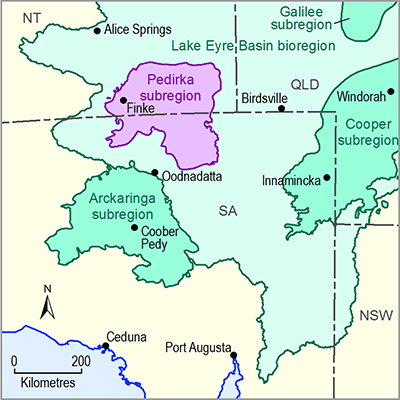Summary
The Pedirka subregion is situated in Australia’s arid zone where highly variable rainfall, low soil fertility, and localised soil differentiation are the dominant physical environmental drivers of ecosystem composition. The subregion contains a diverse range of native flora and fauna.
The region has become increasingly arid over past millennia, leading to the isolation of aquatic ecosystems. Great Artesian Basin (GAB) springs of the Dalhousie supergroup are found near the southern boundary of the Pedirka subregion. These springs have flowed continuously for between one and two million years, providing the only refugia for obligate aquatic species with poor dispersal capabilities. The springs contain a high proportion of endemic species and populations of species that were once widespread. Five species of fish, three crustaceans, and three molluscs are found only at Dalhousie Springs. Recent research on invertebrates in springs indicates that it is likely that levels of endemism have been substantially underestimated to date and the true levels of endemism may be higher than is currently understood.
There are two major surface catchments occurring within the Pedirka subregion: the Macumba and Finke catchments. Both catchments are highly ephemeral and exhibit the ‘boom and bust’ ecology of the Lake Eyre Basin. Large floods occur infrequently, but drive spectacular booms in biotic production. Clusters of smaller floods prolong waterbody persistence and connectivity between waterbodies and produce cumulative responses from aquatic biota. During extended droughts, the entire Macumba catchment dries out, while permanent waterholes in the upstream reaches of the Finke provide refuge for obligate aquatic species in that catchment.
The Macumba catchment drains into Kati Thanda – Lake Eyre via the lower Georgina-Diamantina catchment. With no known permanent waterholes in the Macumba catchment, the nine native fish species found in the Macumba catchment can become locally extinct during extended droughts and are most likely to be reliant on populations in the Georgina-Diamantina catchment to repopulate during flood events.
The Finke River catchment floods out between the dunes of the Simpson Desert in the Pedirka subregion. This catchment is believed to have flowed to Kati Thanda – Lake Eyre between 1,000 and 20,000 years ago. Fish have been observed in the Finke floodout, but there have been no surveys in this reach. These wetlands support a diversity of waterbirds and wetland vegetation types and are of national significance.
Other wetlands occur in the Pedirka subregion, including endoreic drainages, swamps and interdune lakes. Some are known to be of conservation significance regionally, but many are very poorly studied.

Product Finalisation date
- 1.1.1 Bioregion
- 1.1.2 Geography
- 1.1.3 Geology
- 1.1.4 Hydrogeology and groundwater quality
- 1.1.5 Surface water hydrology and surface water quality
- 1.1.6 Surface water – groundwater interactions
- 1.1.7 Ecology
- Citation
- Acknowledgements
- Contributors from the Government of South Australia
- Contributors to the Technical Programme
- About this technical product
